Land target ships at PLA training grounds
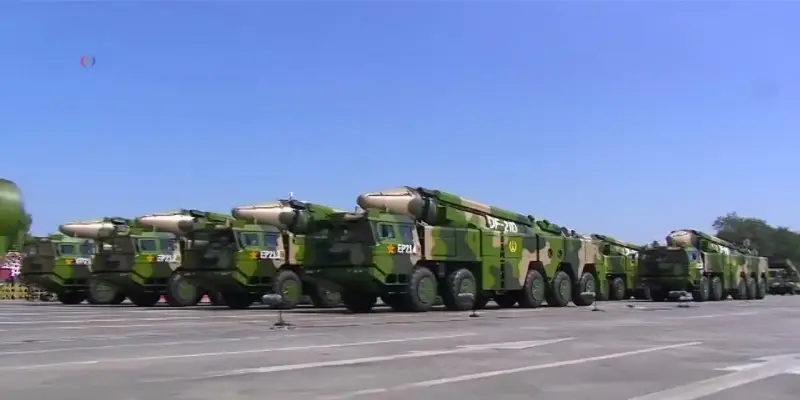
DF-21D missile systems at the parade. Photo: Wikimedia Commons
The Chinese People's Liberation Army is preparing for a major confrontation in the Pacific and is taking the necessary measures. In particular, to counter the naval forces of a potential enemy, various anti-ship missile systems are being created, mass produced and deployed in units. At the same time, to test such equipment and prepare its calculations, special target systems are created at remote test sites, protected from excessive attention from foreign intelligence services.
Rockets and ranges
In the 21s, the Chinese defense industry, commissioned by the PLA, was developing a new generation of anti-ship weapons. By the end of the decade, this process yielded the first result - a complex with a short-range ballistic anti-ship missile DF-26D entered service. Subsequently, the DF-XNUMXB medium-range anti-ship missile was created on its basis. Probably, work does not stop, and new complexes of this kind will appear in the future.
According to known data, tests of new anti-ship missiles were carried out at land test sites deep in the territory of the People's Republic of China. Sites in the Taklamakan and Gobi deserts made it possible to carry out all the necessary activities, but at the same time made it extremely difficult for foreign intelligence services. Probably, some tests of existing or future equipment are still being carried out at these test sites.
Later, after new missile systems were put into service, remote training grounds began to be used for training and training crews. In addition, at some sites, a realistic target environment was created using special equipment. Such measures should have had a positive impact on the level of training of missile crews, and also, probably, ensure the use of the full potential of new weapons.
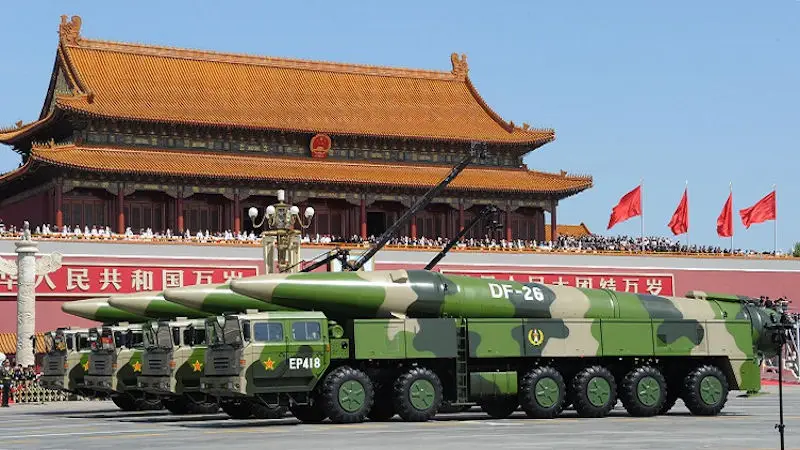
DF-26 complexes with medium-range missiles. Photo Globalsecurity.org
Silhouettes in the desert
The first reports of the creation of target fields specifically for testing the use of ballistic anti-ship missiles appeared about ten years ago. In 2013-14 foreign intelligence services and commercial satellite operators published the first photographs of sites with unusual equipment.
One of the first targets to become famous was at a training ground in the Gobi Desert, which had the simplest appearance. It was a white rectangle the size of a universal landing ship or a large foreign aircraft carrier fleet. According to some reports, several such targets were set up at training grounds in two deserts.
Imitations of large surface ships have been used for their intended purpose many times. Satellite images are known to show a rectangular target after firing. In the silhouette of the target, a pair of missile craters were clearly visible, probably with inert equipment. Several more missiles left marks outside the target.
A Course in Realism
In the mid-1990s, it became known about the construction of a more complex target field. Several target ships, an imitation of the coastline and mooring structures, as well as some coastal “buildings” were placed on it. With the help of such an object, anti-ship missile crews and command could practice solving more complex problems, from conducting reconnaissance and drawing up fire missions to salvo firing and hitting group targets.
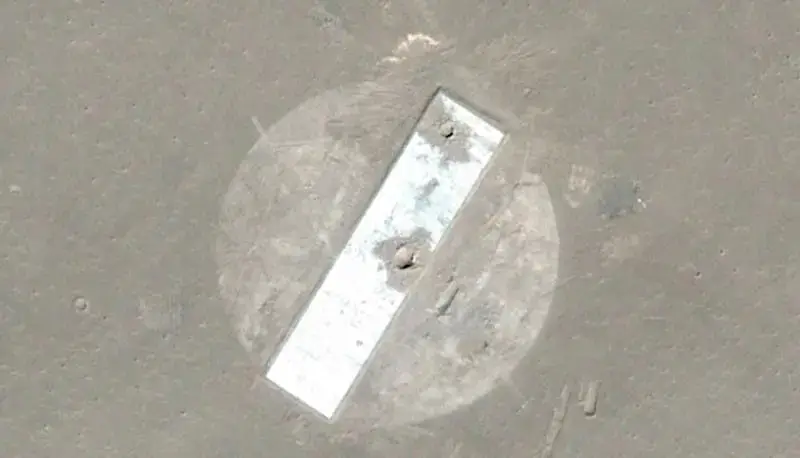
The simplest ground target simulator of a ship with traces of hits. Photo FAS
An interesting feature of the target field in the form of a naval base was the relatively realistic silhouettes of ships. This approach has been developed, and now all new targets are made only in this way - with an eye on real samples of a potential enemy. In addition, additional measures are being taken to more fully simulate ships or other targets.
So, by the end of the tenth years, a target appeared in the form of a silhouette of an American Nimitz-class aircraft carrier at a large training ground in the Taklamakan desert. Similar facilities were also built in the form of current US Navy destroyers. Several of these “ships” were combined into an “aircraft carrier strike group.” Accordingly, crews of missile systems were given the opportunity to train in the fight against group surface targets.
In 2019-21 This target complex has undergone an interesting modernization. Instead of a static target field, rail tracks appeared at the training ground to accommodate the silhouettes of ships. Thanks to this, the target environment is no longer static, and missilemen now have to attack moving objects. Despite the complexity of such a complex, the realism of the exercises and, accordingly, the quality of personnel training have increased.
Since the end of the last decade, new methods of increasing realism have been observed. So, the targets are no longer flat. On a base that imitates the deck of a ship, structures are erected in the form of superstructures and other units. In addition, corner reflectors are mounted on the target, directly or on masts. With their help, not only visual, but also radar similarity of the target with a real ship is achieved.
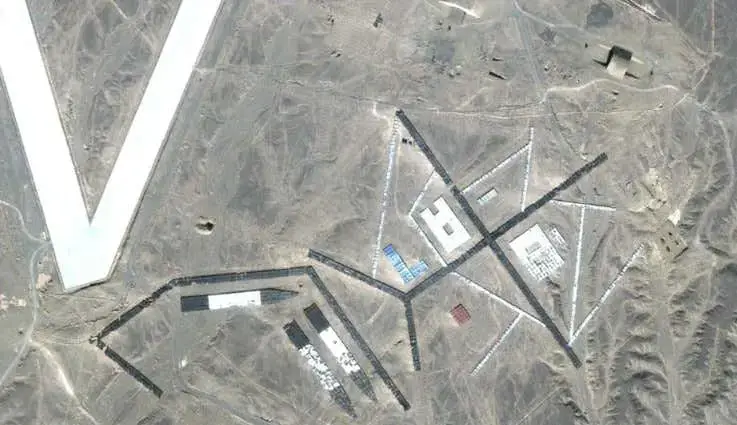
A target field reproducing a naval base. Silhouettes of ships, port facilities and coastal buildings are visible. Photo FAS
Reserve for the future
The PLA considers the US armed forces as its main potential enemy. As a result, the target complexes construction program reflects the current state and development plans of the US Navy. Another example of this became known in early January, when American commercial operators published new images of the test site in the Taklimakan Desert.
The new Chinese-built target follows the contours of the deck of the newest American aircraft carrier USS Gerald R. Ford (CVN-78). It has a characteristic elongated “bow” with starting positions and the main part of the deck is rectangular in shape. On the starboard side of the target there is a “three-dimensional” island superstructure, offset towards the stern. The available images also show various small features on the deck, likely mimicking parts of a real aircraft carrier. It can also be masts with reflectors that create a radar signature.
Apparently, the Chinese model of “Gerald Ford” is stationary and has constant coordinates. At the same time, one cannot exclude the emergence of a similar target for use with a rail installation that already had a Nimitz ship simulator.
To increase efficiency
Over the past 10-15 years, the PLA has been paying great attention not only to the creation of new anti-ship missile systems, but also to improving the efficiency of testing and training of personnel. Target simulators of real ships of a potential enemy are being built, and we are talking about several generations of such complexes with certain features.
The choice of locations for placing target ships is of interest. They are built at remote sites far from sea borders and borders with developed unfriendly countries. Because of this, a potential enemy can observe activities at the test sites only from orbit, and the PLA has the ability to easily hide the most important activities from foreign intelligence.
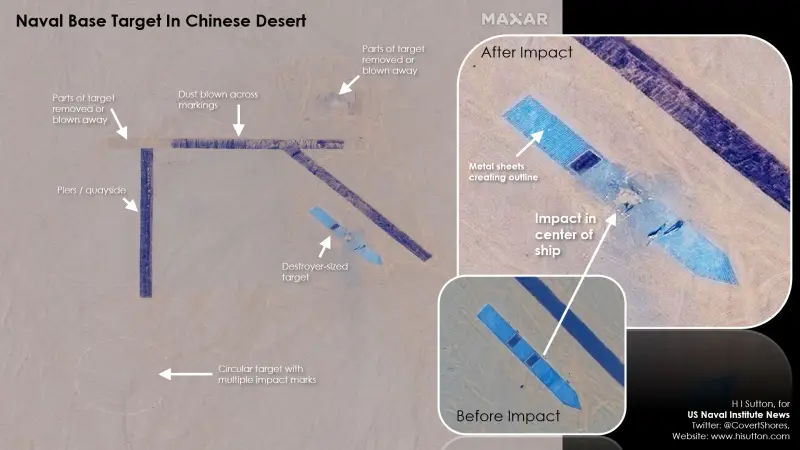
"Naval base" and target ship before and after shooting. Photo by Maxar/USNI/H.I. Sutton
It should be noted that the placement of “sea” targets on land does not create fundamental obstacles or problems for conducting exercises or tests. Moreover, a flat sandy desert, with certain reservations, is an acceptable imitation of the open sea. At the same time, the size of the deserts makes it possible to launch anti-ship missiles from long distances, typical for the proposed real firing.
However, what is most interesting in this situation is the targets themselves and the opportunities they provide within the framework of various events. First of all, the size and appearance of the targets matter. From the upper hemisphere, they are as similar as possible to the real ships of a potential enemy. Efforts are also being made to imitate the radar signature. With all this, Chinese targets copy the main warships of the potential enemy in the person of the US Navy, including aircraft carriers, incl. latest project.
The most realistic design of targets allows you to work out the processes of reconnaissance, target designation and shooting with increased efficiency. Accordingly, tests or research and exercises are carried out with greater benefit.
It can be assumed that the observed story land target ships is directly related to the processes of development of anti-ship weapons of the PLA. In addition, it may give hints about the technologies used in modern anti-ship missiles and other systems.
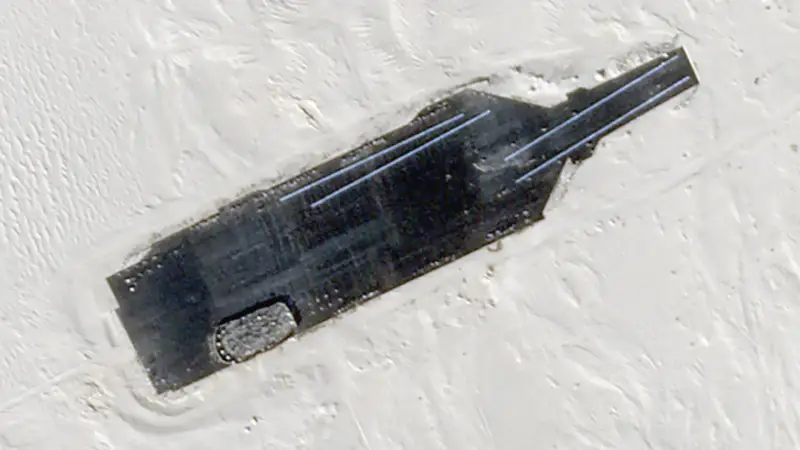
Gerald R. Ford-class target aircraft carrier, January 2024. Photo by Planet Labs
Early targets were distinguished by their simplicity of shape and, apparently, were contrasting only in the optical range. This may indicate the use of only optical reconnaissance means in defense - aviation or satellite. Subsequently, more complex products appeared, visible to optics and radars. This modernization of targets indicates new steps in the development of reconnaissance systems. It also hints at the emergence of full-fledged optical or radar seekers for ballistic anti-ship missiles.
Recently, the PLA has been using moving targets that most accurately simulate individual ships and small detachments. The benefits of such systems are obvious - reconnaissance and missile forces get the opportunity to work in conditions as close as possible to a real operation. It is curious that in this case, anti-ship missiles must use their full potential and provided combat capabilities. In fact, the only thing better than such exercises is shooting at a real target ship.
A complex approach
Thus, the PLA is actively developing its missile weapons to combat the enemy’s surface fleet and is not limited only to the development of promising systems and complexes. For effective testing and training of personnel, special target systems are being built at training grounds. From the available data it follows that they are regularly used for their intended purpose and contribute to the growth of missile potential.
It should be noted that the construction of target simulators of ships on a land training ground is a very unusual idea with its pros and cons. However, the Chinese army appears to have been able to find ways to maximize the potential of this concept. As a result, the PLA practices the use of modern weapons, and the potential enemy receives an obvious signal warning him against rash actions.
Information